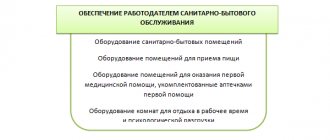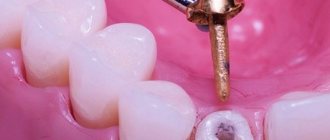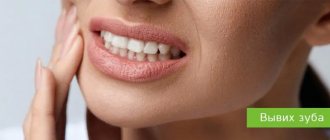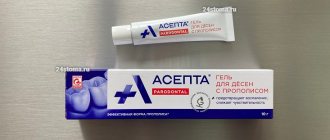For many people, rotten wisdom teeth pose a real and very serious threat to the health of the entire oral cavity - problematic third molars or, as they are also called, “eights” cause a lot of trouble for their owners. They erupt much later than the rest of the dentition (at about 20-25 years) and often become a problem already at the eruption stage.
What complications can wisdom teeth cause?
Difficulties arising from third molars are primarily associated with the late timing of their eruption and some anatomical features of the jaw structure:
- Lack of space for normal eruption. By the time the “eights” begin to cut, a person’s dentition is usually already fully formed, and there may simply not be enough space for the third molars. In addition, during evolution, the human jaw has decreased by about 1 cm, which also does not contribute to the normal growth of “eights”. In this case, tooth extraction is indicated to prevent displacement of the entire dentition.
- Incorrect position in a row (dystopia). Leads to soft tissue injuries, destruction and displacement of adjacent teeth.
- Incomplete eruption (retention). Impacted “eights” cause a lot of problems and discomfort - often such a wisdom tooth causes inflammation of the gums and diseases of the “neighbors” in the dentition.
- Pericoronitis. An inflammatory disease characterized by swelling of the gums near the wisdom tooth followed by suppuration. When teething is difficult, a so-called hood of mucous membrane is formed around the figure eight, which is the optimal place for the accumulation of food debris and the proliferation of bacteria. In this case, the wisdom tooth is cut and hurts due to inflammation of the hood. If nothing is done, gum inflammation develops not only next to the tooth, but throughout the entire jaw - this will require long-term and costly treatment of the gums.
- Deep caries of wisdom tooth. Third molars, as a rule, begin to deteriorate quickly, often at the eruption stage. Why do wisdom teeth crumble? This is due to both the peculiarities of its structure and its position: it is simply impossible to clean the “eights” well with paste and a brush, so food debris and bacteria necessarily accumulate there, creating favorable conditions for the development of infectious processes.
In all the described situations, it is better to remove wisdom teeth immediately, without waiting for serious complications to develop, and you will have to spend a lot of time and money on treating nearby teeth, as well as inflamed gums.
Symptoms of the disease
The process usually occurs without symptoms, but pain may occur when brushing a toothbrush, eating sour, salty, sweet, cold or hot foods.
After eliminating the irritant, everything goes away. The patient can see a doctor if a stain is found on the front surface of the incisors, but often it is hidden under plaque or tartar.
The ongoing carious process gradually reaches the dentin junction, penetrating first into its surface layers and then further. The cavity deepens with bacteria and food debris. There is a smell from the mouth. Irritants cause pain more and more frequently.
With cement caries, teeth become mobile and lose their support, and bleeding gums occur. These are already symptoms of periodontitis. Now, even when chewing food or brushing teeth, severe discomfort occurs.
Digestion begins to suffer. Teeth become hypersensitive to hot or cold.
Next, the process follows the Leus classification:
- Active lesion - the edges of the cavity are undermined. The cavity is filled with softened tissues and tends to grow.
- Suspended caries - no increase in the affected area is observed. The cavity is clean, the bottom is shiny and smooth, the edges are even and dense.
- Secondary caries - occurs under a filling.
Can third molars be treated?
Wisdom teeth, like any other teeth, can be treated. But only if they erupt correctly, do not threaten the health and position of the rest of the dentition, and there is confidence that the treatment will be successful. If the specified conditions are met, it makes sense to preserve the “eight” for the following indications:
- If the sixth and seventh teeth are sick or severely damaged and must be removed, in this case the wisdom tooth is left as “the best of the worst” in order to provide the patient with at least some conditions for chewing, and the doctor - the basis for future prosthetics.
- If the six and seven have already been removed and it is necessary to preserve the abutment tooth for installation of prosthetic structures.
- In the presence of an antagonist tooth, completely healthy and subject to preservation.
In case of curved roots that complicate endodontic intervention, severe tissue destruction, dystopia or retention, no competent dentist will undertake to treat the “eights” - he will definitely recommend removal.
What preventative measures are there?
To keep your teeth healthy for many years, you need to brush your teeth twice a day, use floss and a tongue scraper. After sweets, you should rinse your mouth and chew gum for 5-10 minutes.
Prevention also includes the removal of tartar. A sufficient amount of saliva is also important, so it is necessary to maintain a water regime.
Like any other pathology, caries is better prevented than treated. Therefore, it is important to visit the dentist twice a year for preventive examinations. People at risk should approach this especially responsibly.
Other
Why are wisdom teeth needed?
Why does our body need third molars at all? In fact, these are rudiments that not all people today erupt - approximately a third of the entire population of the planet does not even have the rudiments of third molars, although a few thousand years ago absolutely all adults grew wisdom teeth. They practically do not perform the chewing function, since the rest of the healthy teeth usually cope with it.
Today, “eights” are needed only as a “backup option” in case the first and second molars fall out or are severely damaged, and also as a factor preventing the loosening of neighboring teeth. They can also serve as a support for prosthetics - but, again, in all these cases we are talking about healthy and correctly erupted “eights”. In the same case, when a person has rotten wisdom teeth in his mouth, they will not be able to perform any of the indicated functions and it is better to remove them so as not to expose the rest of the dentition to the risk of infection.
Indications for removal
Healthy, well-positioned third molars with good oral access for possible treatment do not need to be extracted. There are clear indications for such an operation, and if they exist, it should be removed without waiting for complications:
- Deep caries of the wisdom tooth, as well as lack of normal access for full treatment.
- Chronic inflammatory processes caused by third molars, including in cases where the wisdom tooth caused inflammation of the gums.
- Chronic injuries to the oral mucosa due to incorrectly positioned “figure eight”.
- Impacted or dystopic teeth.
- The need for orthodontic treatment of bite defects if the doctor believes that the “eights” will prevent the dentition from occupying the correct position.
In all of these situations, it is recommended to remove the “eights” without delay.
What is it - erosion of tooth enamel
When dental diseases develop, in most cases it is the enamel, which is the surface of the tooth, that is affected. The more serious the damage, the more dangerous the pathology, since the tooth is left without protection and its functionality is completely impaired.
Tooth erosion is a common disease in which severe thinning of the enamel to dentin occurs. The enamel is destroyed symmetrically on all teeth in the oral cavity with the exception of molars.
The pathological process is accompanied by painful sensations when eating and drinking drinks, brushing teeth and even inhaling cold air. In addition to physiological and functional disorders, there is a serious aesthetic defect. If tooth enamel erosion is not advanced, then therapeutic treatment can give a positive result. However, if the tooth is severely damaged, then it can only be restored using the restoration method.
Removal Features
As a rule, operations to remove third molars are always considered difficult, since these are the teeth that usually cause more problems. The operation can be simple, provided that the “figure eight” is located on the upper jaw and does not have pronounced developmental abnormalities. In all other cases (as well as in situations where the tooth is in the upper jaw, but has strong, curved and branched roots), the operation is considered complex and must be performed by a qualified dental surgeon.
Before performing an intervention, the doctor determines possible contraindications for a particular patient, examines an x-ray of the problem area and determines the optimal tactics for the operation. The duration of the procedure ranges from 1-10 minutes for simple removal and up to 20-120 minutes for complex removal, requiring a series of manipulations and suturing of the hole.
Is it possible to cure tooth decay at home?
Treatment of caries at home is advisable only at the initial stage of the disease. However, only a dentist can correctly determine the stage of the disease.
Remineralizing pastes and gels with calcium and fluoride can be used as effective treatments for caries at the spot stage. Regular use of these products will prevent further development of caries and reduce tooth sensitivity to external irritants.
You should not choose a paste or gel on your own. This should be done by the attending physician, who will make a choice in favor of a particular remedy, based on the approximate percentage of fluoride and calcium in the person’s diet. Most often, dentists advise alternating pastes containing calcium and fluoride.
In case of severe tooth sensitivity, the paste can be used not only for its intended purpose, but also for applications.
Medium, deep caries cannot be cured at home - the disease will gradually progress even if the factors provoking the disease are reduced.
Removal of wisdom teeth under general anesthesia
Many patients are afraid to remove problematic “eights” because they fear that the process will be painful. However, you should not postpone the operation because of your own fear: modern methods of anesthesia allow the removal to be performed as painlessly and comfortably as possible for the patient.
Doctors usually recommend performing the intervention under local anesthesia, which will be sufficient to ensure the patient is comfortable during the operation. If for some reason a person is not satisfied with the methods of local anesthesia, there is always the possibility of having a wisdom tooth removed under anesthesia. It should be remembered that this option of pain relief is not available to everyone - there are certain contraindications:
- Decompensated diabetes mellitus and cardiovascular diseases.
- Post-infarction or post-stroke periods for up to 6 months.
- Acute inflammatory diseases of internal organs, including the respiratory system.
- Epilepsy.
- Severe thyroid disease.
- Bronchial asthma.
- Alcohol or drug intoxication.
The presence of at least one of the listed positions makes the removal of wisdom teeth under general anesthesia impossible. Before the operation, the patient must be examined to identify any contraindications to the use of anesthesia. In addition, you need to remember that certain preoperative preparation will be required, and the clinic itself, in which the wisdom tooth will be removed under anesthesia, must have all the necessary equipment, as well as a team of specialists who will treat and monitor the patient’s condition (anesthesiologists, resuscitators, trained nursing staff).
Treatment of caries on baby teeth
Many parents, having noticed caries on their child’s baby teeth, believe that nothing needs to be done - these teeth will fall out anyway. However, such a decision is explained by ignorance: not every person knows what kind of caries is treated in modern dental clinics.
When visiting a doctor, a child undergoes:
- ozone therapy is a modern method using a powerful jet of ozone used for antibacterial treatment;
- infiltration is a method in many ways similar to ICON, but a filling is not installed (the doctor is limited to isolating the cavity);
- abrasive cleaning - the method is suitable for the initial stage of caries, has many similarities with professional cleaning of the oral cavity;
- silvering - the enamel is coated with a solution of silver diamine, which disinfects the surface. The method is rarely used due to its low aesthetic appeal - teeth remain black until they fall out;
- Conservative treatment for more serious lesions, accompanied by pain relief.
Treatment or removal during pregnancy
In cases where a wisdom tooth is cut and hurts, causing constant discomfort to the pregnant woman, it can and should be treated regardless of the gestational age. If there is no acute pain and treatment can be postponed, then it is advisable to carry it out in the second trimester of pregnancy or after childbirth.
It is worth remembering that wisdom tooth removal, especially under anesthesia, is definitely contraindicated for pregnant women. Removing third molars is strongly not recommended due to the complexity of such an operation and the risk of developing postoperative complications. As for anesthesia, it cannot be used either for removal or for treatment - during pregnancy, only local anesthesia can be used, and the drugs should be selected very carefully and taking into account the patient’s condition.
Despite their name, wisdom teeth do not bring their owners increased intellectual abilities, but they can cause a number of very unpleasant problems with oral health. Typically, third molars “lead with them” swelling of the gums, purulent inflammation, the development of caries of neighboring teeth, as well as severe pain. Therefore, in modern dentistry they prefer to remove them, without waiting for serious complications to arise and longer and more expensive treatment to be required. In many European countries today, a common practice is to remove the “eights” immediately after their appearance, regardless of their condition and the correctness of eruption.
Treatment
The dentist’s task is to stop the destruction of bone tissue, prevent sepsis, and alleviate symptoms.
For this purpose, therapeutic and surgical methods are used, such as:
- Drug therapy
Broad-spectrum antibiotics, antihistamines, and aseptic mouth rinses are prescribed. For pain, analgesics are prescribed.
- Surgical intervention
The doctor performs curettage of pockets or sockets of extracted teeth. Removes sequestration, opens and provides drainage of purulent foci, splints mobile teeth.
Depending on the stage of the disease, an operation is indicated in which the affected bone is completely removed, leaving only its healthy part.
In many cases, reconstructive surgery must be resorted to to fill the defect or correct the deformity. This could be a bone transplant or jaw restoration.
Treatment of jaw necrosis is a multi-step process that requires the participation of several doctors. Depending on the nature of the disease, the dentist works closely with an oncologist or general practitioner. For reconstructive operations under general anesthesia, the participation of an anesthesiologist and an oral and maxillofacial surgeon is required.








